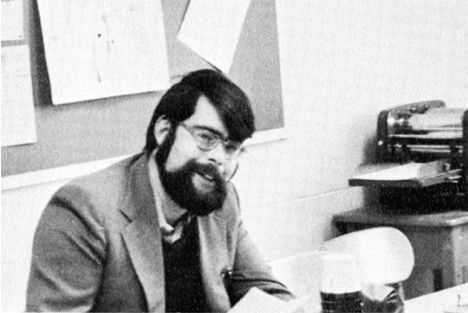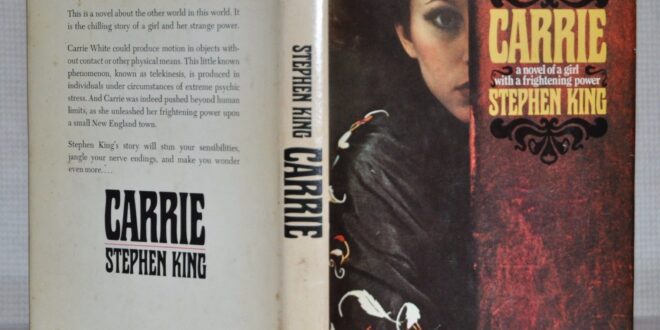If you’re an aspiring writer, you don’t have to look very far for an inspiration to never give up. Once upon a time, a 24-year-old struggling writer was living in a small trailer with his wife and two kids in utter poverty. He worked during the day as an English teacher and in the evenings as a laundromat attendant before coming home to type on his typewriter anything he could think of. In 1971, the writer thought about a girl getting her first period in the shower and how horrifying it must be to any girl to have to experience that. After reading about telekinesis in Life Magazine, the writer decided to combine the two elements into a short story to be published in Cavalier Magazine. That writer was named Stephen King and the genesis of the novel CARRIE was born.

Stephen himself thought he was in no position to write about high school girls since he had been out of high school for over five years and he was not, in fact, female. After typing out three pages, Stephen thought that it wouldn’t appeal to anyone and threw his work in the trash. While taking the trash out, Stephen’s wife Tabitha – herself an aspiring writer – took a look at what he had wrote and asked why he tossed it out. When Stephen answered that he knew jack about high school girls, Tabitha said she’d help him out. Stephen then sought out two women he knew to get some inside information on their backgrounds. One was bullied heavily for being so poor that she only wore one outfit to school, and the other was the daughter of a fanatical religious family. Getting info from both of them and his wife convinced Stephen to continue what he thought was “a waste of time.”

So what did Stephen cobble together? Sixteen-year-old Carietta “Carrie” White is bullied relentlessly, not just by her high school classmates, but her religious zealot of a mother, Margaret. When Carrie has her first period in the shower, she freaks completely out because her mother never taught her about it. The classmates mock her by tossing tampons at her until the gym teacher tells everyone to scram. As Carrie goes home in despair, she starts using her telekinetic power to control objects from a distance. The next day the gym teacher, Ms. Desjardin, has the entire class given detention and the leader of the pack, Chris Hargensen, tells Ms. Desjardin to pound sand. Desjardin has Chris suspended and banned from the upcoming high school prom. In typical American society, Chris whines to her wealthy father to get her off the hook. Rather than discipline his brat of a daughter, Mr. Hargensen unsuccessfully argues to let her go to prom. Chris vows revenge but she has no idea what Carrie is capable of. Without spoiling the ending, let’s just say Chris should NOT have messed with Carrie, especially at the prom.

When Stephen was finished, he published his short story around 1971 in one of the men’s magazines he frequently sent in stories to. In 1973, editor and friend Bill Thompson went through Stephen’s short stories looking for something they could turn into a novel. Thompson looked at CARRIE and thought it had potential with a little bit of a re-write. Stephen’s original ending had Carrie growing horns and taking down an airplane 35,000 feet in the air. Thompson said that was too silly and had Stephen re-write a new one more suited for realism. After the re-write was over, Thompson sent the completed work to Doubleday Publishing executive editor Lee Barker to get it published. Barker liked what he read and promised Stephen a $2,500 advance for the hardcover book. The sad part about that was Stephen was so broke that he didn’t have a telephone, so Thompson had to send Stephen a good old-fashioned telegram announcing the news. Adjusted for inflation, $2,500 would amount to $16,425 today.

But wait there’s more! On April, 5 1974, the hardcover version of Carrie was released. One month later, New England Library president Bob Tanner sent a copy of the book to New American Library for paperback publishing. Now living in a proper apartment and being able to afford a phone, Stephen got the call from Thompson that he was getting $200,000 for the paperback rights to Carrie. Stephen himself claims this caused the author to slide down the wall in shock. Once again adjusted for inflation, $200,000 in 1974 would be around $1.18 million dollars today. The hardcover book sold between 13,000 and 17,000 copies but the paperback sold over a million by the end of 1976. One of the reasons the book sold so well two years after it was published was that movie director Brian De Palma pushed to make a film adaptation after reading it. When the studio approved, the husband of actress Sissy Spacek (Coal Miner’s Daughter – 1980) pushed for her to audition for the role of Carrie White. The movie adaptation of Carrie was a classic, starring not only Spacek but Nancy Allen and heartthrob John Travolta (Grease – 1978).

Today, Stephen King is one of the most well-known authors in American history as both film and written adaptations of Carrie were a huge success. Not bad for a manuscript that was thrown in the trash three pages into it by the young writer who was writing it. It just goes to show it takes determination, talent, and a little bit of luck to get ahead. For those thinking whatever you’re writing won’t appeal to anyone, or if you’re having trouble writing something, just remember a near penniless Stephen King was able to kick down the door of the horror genre with a little bit of help from his friends. That could be you someday.
 PopHorror Let's Get Scared
PopHorror Let's Get Scared




